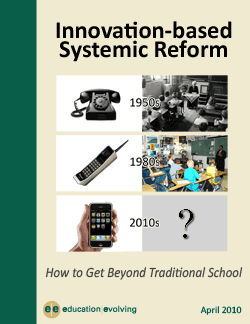Report • April 2010 • By Ted Kolderie
It would be very strange for education policy to turn its back on innovation. New technology has great potential to change and improve ‘the learning system’ — as it has been changing other systems that essentially manipulate information. Yet in the policy discussion the pressure is very strong simply to improve traditional school. A key question for policy is: How to open to innovation while working also to improve traditional school? This new paper lays out what Education|Evolving believes is the only realistic answer.
The key idea is to let education change as other systems change. That is: For new models using new technologies to appear and to run alongside the traditional; for policy to be pursuing different goals simultaneously. It is the concept of a ‘split screen’.
Those attracted by the new models may go there; those who prefer the traditional may stay there as long as they wish. Think: typewriters and computers; hard-line phones and cellphones. As strategy opens beyond traditional school we are likely to see school taking new organizational forms, to see technology individualizing learning and to see broader concepts of achievement maximizing student motivation. A toleration for the ‘different’ will replace the search for the “one best way” that has paralyzed the effort to improve student learning for so long.
This will challenge national policy. Unable itself to change the K-12 system (which exists in state law), federal officials are torn between requiring traditional schools to ‘do better’ — to ‘turn around’; to adopt ‘best practice’ — and encouraging the states to let schools and teachers innovate; trying things they believe will help the students they actually have enrolled. Again, the practical answer is: Do both.
Innovation will challenge public attitudes as well. New and personalized approaches to learning, schools organized as teacher partnerships and concepts of ‘achievement’ that go beyond content knowledge will seem to many not “real school”. But K-12 has to change if it is to progress; if it is to improve learning and to improve its economics, its productivity. The “split screen” approach will ease the transition; will produce more change more quickly than could the process of politics.

Download Full Report (PDF)
These ideas, in talk form
EE co-founder Ted Kolderie spoke about these ideas in a talk at the 2010 Knowledge Alliance retreat.